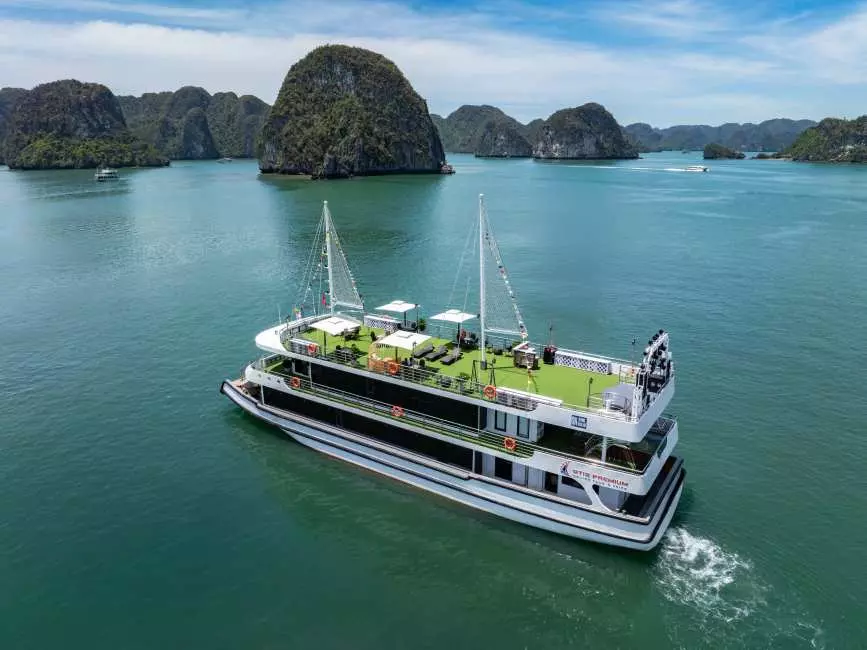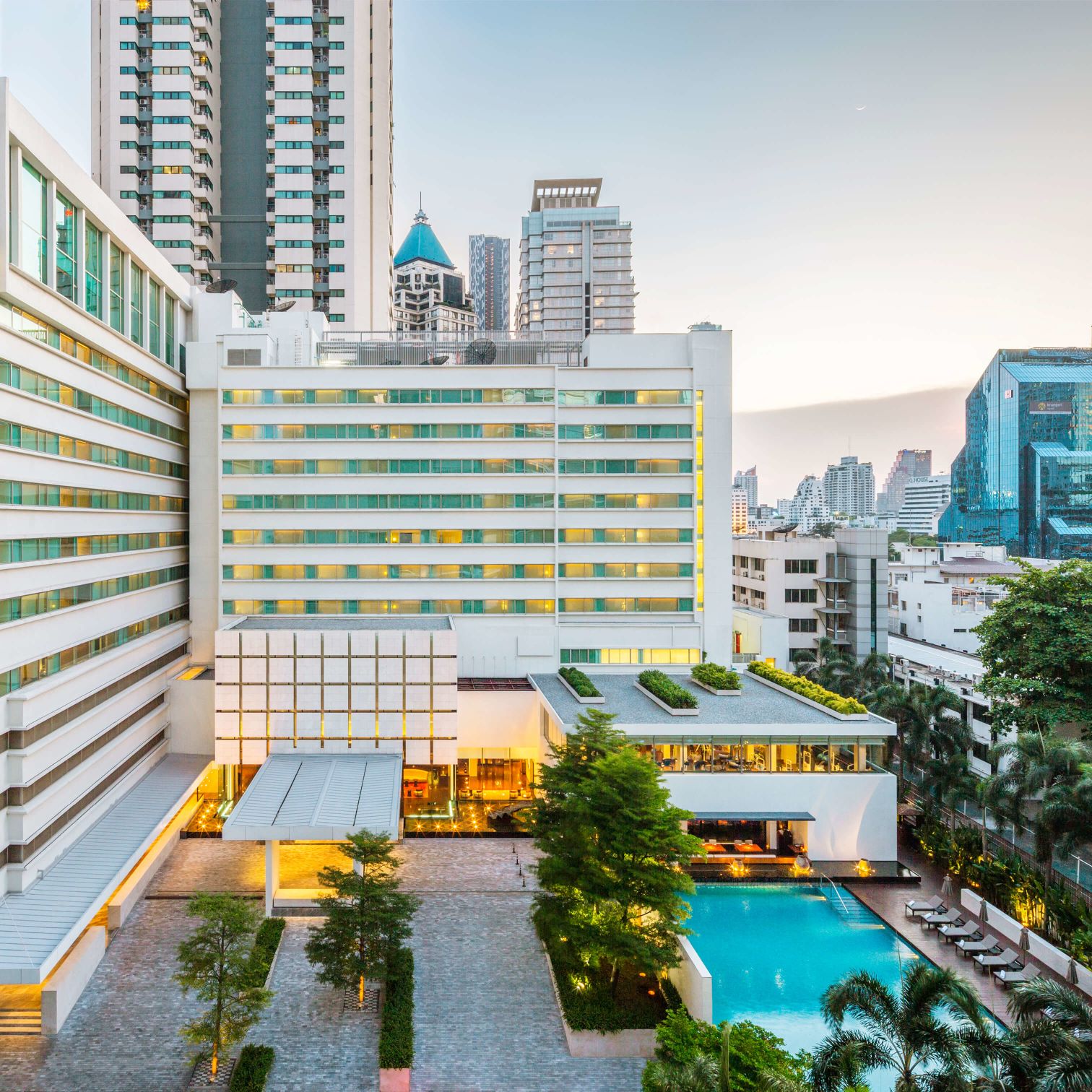On Tasmania’s unsullied east coast, a bastion of design and luxury comes complete with generous hospitality, stunning views and inquisitive locals.
I’m being followed; I can feel the prickle on the back of my neck as multiple sets of eyes bear down on me and hear the faint rustling of footfall in the surrounding bushscape. I quicken my pace, but too late. My pursuers emerge from the inky blackness of night to stand in front of me.
Nocturnal encounters don’t come much cuter than being trailed by a pair of fluffy, rambling possums, both of whom don’t seem troubled in the slightest by my presence. In fact, they appear to be pretty determined to follow me all the way back to my room.
I must say that I can’t really blame them for being curious; since launching earlier this year, Freycinet Lodge’s luxe Coastal Pavilions have been garnering a lot of attention, albeit more typically from humans fascinated by the stunning architecture and gracious hospitality of these wood and glass-shrouded pods set among the pristine landscape of Tasmania’s Freycinet National Park.
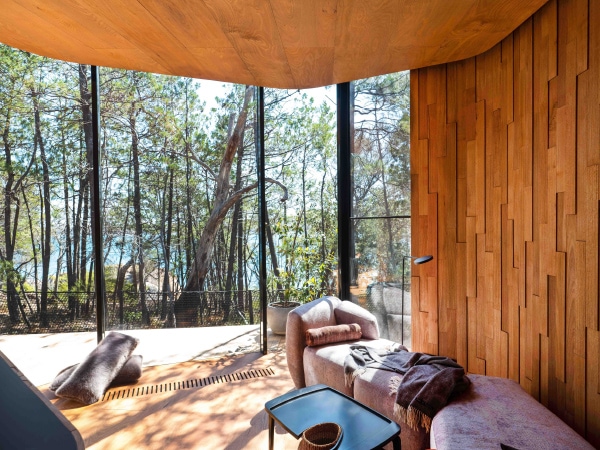
Walls are clad in a jigsaw puzzle of wood that looks as lovely as it smells
Hobart to Freycinet Lodge
Arriving into Hobart airport the previous day, the 2.5-hour journey along the achingly beautiful Great Eastern Drive to reach the finger-like Freycinet peninsula is an exercise in anticipation. The road skirts the coastline for most of the drive, affording breathtaking views of endless blue seas meeting a white cloud-dappled blue sky on one side, and rolling countryside on the other, its bleached-out taupe and green landscape punctuated by eucalypts and grazing sheep.
With time to meander, there’s the option to duck off the road towards the ferry port for Maria Island, to take a day trip to see historic convict ruins and the dramatic windswept landscape, or stop at Orford, with its deep white sand beaches and plentiful holiday homes. I do stop in Swansea, a pretty, historic village that like Orford swells in population during the summer months. The main thoroughfare is dominated by the imposing three-storey stone and brick Morris’ General Store, built in 1838 and still owned and run by the Morris family, while the Bark Mill Tavern and Bakery does a roaring trade.
Back on the road, the remainder of the journey towards the sleepy seaside holiday village of Coles Bay, overlooking the wide expanse of Great Oyster Bay, and the start of the Freycinet National Park just beyond it is punctuated by signs for berry farms, farm gates and wineries, and ‘stop-the-car-now’ photo opportunities.

Curved floor-to-ceiling glass appears to weave its way through the trees
First impressions
Approaching Freycinet Lodge, the hulking profile of the Hazards Mountain Range strikes dramatically towards the sky in front of me, all but filling the expanse of the car’s windscreen. It is an awe-inspiring sight, the perfect full stop for the journey and a precursor to the experience to come.
The site where the lodge now stands, secreted away among the gum trees and native flora, was first developed for pleasure when the Tasmanian government allowed local Ron Richardson to annex a small patch of land overlooking the bay. The local pioneer and keen pilot set about building a collection of 14 holiday shacks around a central building, known as the Chateau. They were hugely popular with holidaymakers, and in 1939 Richardson acquired additional land and added more shacks.
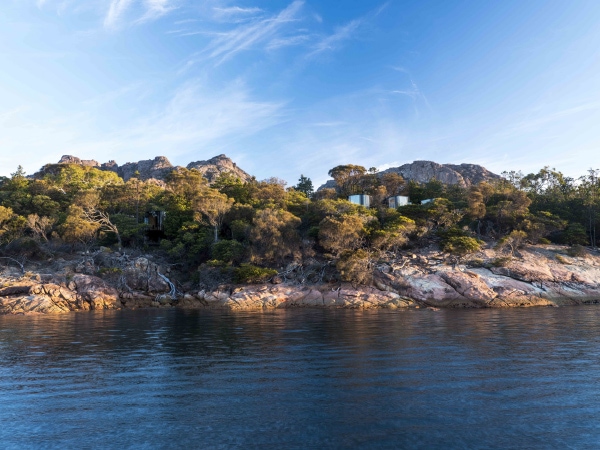
The pavilions are secreted away in the bush on the shores of Great Oyster Bay
The original Chateau was destroyed by fire in 1953, and Richardson couldn’t afford to rebuild. Over the years the land (and what was left of the original property) had various owners until it was sold to a developer in 1990 and eventually launched as Freycinet Lodge in 1993.
The impressive stone and timber central lodge, the heart of the property, dates from this time, and still offers up a gracious welcome with its soaring beamed ceilings, stone-stacked fireplaces and uninterrupted views out over the waters of Great Oyster Bay. While the original roster of 38 cosy twin and family cabins has grown over the years, I am here to see the latest addition, the Coastal Pavilions.
The room
After checking in, experience manager Andreas Huck walks me to my pavilion along an elevated deck that weaves its way through the trees (surprisingly few trees were sacrificed during building; those that were have been replaced with new native plantings) to a bright orange door. Upon entering I am greeted with an uninterrupted view of trees and water across a generous wooden deck complete with an outdoor bathtub. To my left is the bedroom, with its king bed, lush textiles and fittings. And to the right I walk through the bathroom space, past the mammoth glass-fronted shower (every room is anchored by the view) and follow the sinuous curve of the walls into the living area, fronted by more floor-to-ceiling windows.
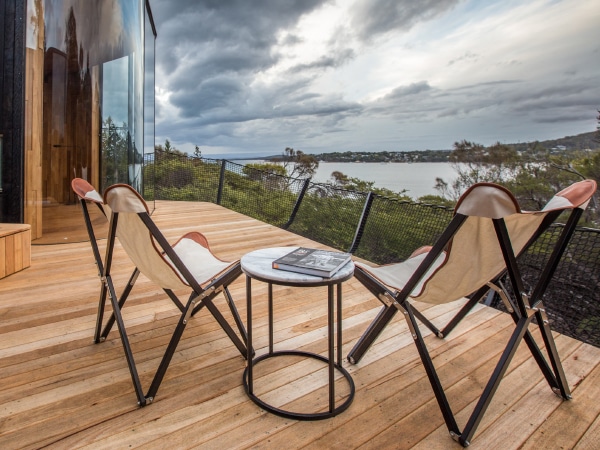
Hammock netting surrounds the decks
Design details
Conjured by Hobart-based design studio Liminal Architecture, the details within each of the nine pavilions are exquisite. Almost the entire interior is clad in a jigsaw puzzle of wood panels that give it a warm and instantly welcoming appeal, as well as smelling fabulous; the toilet is tucked into a curved nook behind a hidden door; there are no sharp corners, creating the effect of being enveloped by the space rather than just occupying it.
Every inclusion is an exercise in design fulfilment: textiles are lush, tactile and subdued so as not to dominate the space; splashes of colour adhere to a strict palette; light fittings and hardware are state of the art and unobtrusive (maybe a little too much so: Huck explains that the stylised black-on-black switch panels throughout that control the lighting etc. are so understated that guests can’t actually see what they are doing; they have since been replaced).
Extra touches
But while the design is spectacular, much attention has been laboured on making the actual experience of staying in the Coastal Pavilions the hero. Behind recessed doors a cupboard is filled with board games and puzzles, books on the local flora and fauna, binoculars and a handy backpack to take with you when (and if) you finally feel like venturing out and exploring. There’s even a hair straightener in the bathroom (among the heavenly Appelles products) should you feel the need to arrive at dinner in the lodge with impeccably groomed tresses.
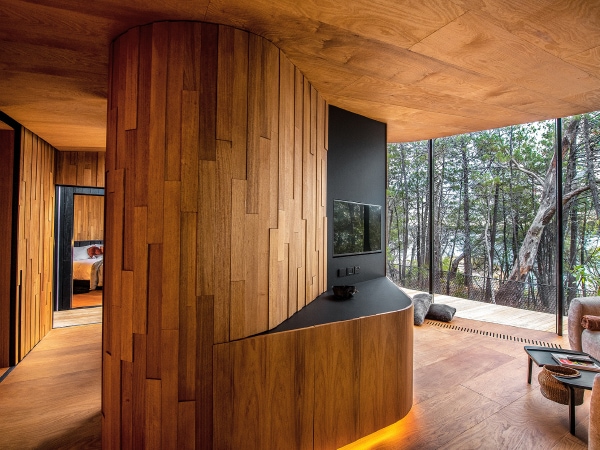
Designed by Hobart-based design studio Liminal Architecture, rich wood panelling creates a flowing sense of space
Nearby sights & attractions
Over the next few days it is almost a chore to wrench myself away from my cocoon; I head to breakfast in the lodge one morning, but choose to have it delivered to me the next in order to max out my ‘room time’. Another day I opt to have a packed lunch made for me before heading off towards the nearby Lake Tourville Lighthouse with its dramatic coastal cliff views of the roiling Tasman Sea, and driving down a secluded dirt track to stand blissfully isolated and alone on the ethereal expanse of friendly beaches.
When the weather permits you can take a scenic flight over the celebrated Wineglass Bay, but the wind puts paid to that while I am in residence; I am guiltily relieved, content to spend the time lounging on the deck in the sunshine, even trying out the hammock-style netting that extends out from the deck over the bush and scrub below.

Trees are a constant presence through the floor-to-ceiling glass
Food & drink
In spite of its remove from the world, it is surprisingly easy to eat well while at Freycinet, with Coles Bay’s Marine Farm just down the road offering up fresh seafood, including Tasmanian oysters, and Devil’s Corner Cellar Door further along at Apslawn. I dine in the Bay Restaurant in the lodge, with the seasonal menu brilliantly showcasing delicious local produce.
But every foray out to explore the surrounding landscape only heightens the thrill of coming back to the pavilion at the end of it. The drama of approaching the inky black facade etched into the landscape (or all but hidden from view against the starry night sky) or the wonder of standing at the imposing windows looking out at the constantly changing weather playing out on the trees and the water and the sky is a privileged experience afforded to those visitors lucky enough to dwell here for a time. Or those furry locals bold enough to amble along for the ride.
View this post on Instagram
Details
Getting there
Qantas flies daily to Hobart from most capital cities. The drive along the Tasman Highway will take roughly two and a half hours. Freycinet Lodge can also be reached from Launceston; the drive takes about two hours. You’ll need a pass for each day you intend to stay in the national park ($24 per day; available from reception), which should be clearly displayed in your car at all times.
Staying there
Rates for the Coastal Pavilions start from $949 per night.
Eating there
Book at least one dinner at The Bay Restaurant to experience the seasonal menu of delicious Tasmanian produce. Head to Freycinet Marine Farm and snag a spot on the deck to enjoy incredibly fresh seafood. The Devil’s Corner Cellar Door offers up more fresh seafood at the Fishers, and wood-fired pizza and good coffee in Tombolo Cafe.
Playing there
Explore Freycinet National Park by car or on foot; Richardson and Friendly Beaches are a must, and the walk to Cape Tourville Lighthouse offers stunning views and whale watching. Take a morning drive to the pretty seaside town of Bicheno an easy 40 kilometres’ drive away. The Farm Shed Wine Centre does Tasmanian wine tastings, or you can grab a coffee and sweet treat. Book a 45-minute scenic flight over Wineglass Bay and the Freycinet Peninsula with Freycinet Air
